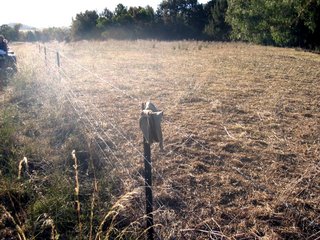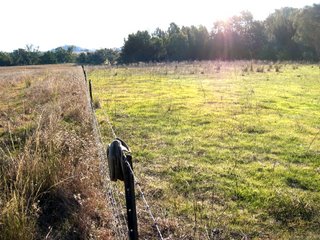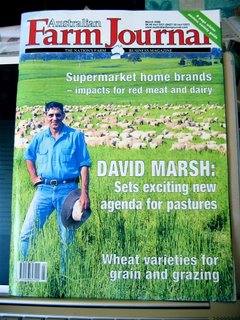(For those visitors who have just joined us, "Uamby" was selected last year by our local Catchment Management Authority to compete with 10 other farms iin developing an innovative whole farm management plant that helped improve water management and salinity levels in the Cactchment. Three winners could receive up to %100,000 to put their plans into action. We are due to suibmit our plans next week - on the 31st May - and here is an outline of what we will be submitting)

YOU'D LOOK WORRIED TOO IF THE DEADLINE FOR THE BIG 100 GRAND BID WAS NEXT WEEK
Farming Systems Program
Natural Resource Plan
Plan Title: Uamby, A Carbon Farm
Total Area that plan will be implemented on: 1780 acres
Will this plan address salinity flows in the landscape Yes
Is this plan innovative in method or arrangement? Yes
Will this plan communicate benefits to the wider community? Yes
Give a brief description of your plan (two sentences): Using soil carbon as the key indicator, we plan to trial various pasture management techniques to identify the most productive for each soil type on “Uamby”, then farm the soil to its maximum carbon capacity. We intend to make “Uamby” a learning centre for landholders interested in Soil Carbon Farming for the purposes of better soil fertility, water usage, environmental outcomes (soil structure and salination), and sequestering (Carbon Credits).
Will this plan address Catchment Action Plans relating to Salinity? Yes
Will this plan address Catchment Action Plans relating to Water Quality? Yes
Will this plan address Catchment Action Plans relating to Vegetation And Biodiversity? Yes
Will this plan address Catchment Action Plans relating to Soil Health? Yes
Will this plan address Catchment Action Plans relating to People And Community? Yes
Will this plan address Catchment Action Plans relating to Cultural Heritage? Yes
Will this plan address Catchment Action Plans relating to Monitoring? Yes
Executive Summary:
By turning Uamby into a ‘carbon farm’ we intend to manage the soil for increased carbon because we believe this will solve the problems we have with the natural resource base (poor soil structure, poor water retention, salination, and low fertility). Additionally we look forward to the opportunity to derive income from carbon sequestration and the sale of carbon credits.
Soil Carbon is to be the primary KPI.
The plan calls for mapping the soil types, then core sampling to assess base carbon levels, then assigning test plots for measuring and demonstrating the impact of a variety of pasture management techniques.
Such techniques will include the following:• Pasture Cropping • Composting • Nitruhumus • Paramagnetic Rock Dust • Mulching
These techniques will be tested against a background of native perennial pastures subject to Time Controlled Grazing. The influence of regrowth of native vegetation on soil biota and biomass will also be measured.
Until you measure something, you can’t manage it. So establishing the measuring system is paramount to the success of carbon farming.
The ultimate goal is to be able to determine the rate of carbon increase/sequestration for certain types of grassland under a certain type of management. So we can have an accurate estimation of how much sequestration is possible in what type of country under what type of conditions.
Catchment Targets Summary:
(Please explain how your plan will address the vision of the Central West Catchment Authority- “Healthy Landscapes And Vibrant Communities”)
The food chain starts with the microbial life in the soil. Carbon rich soils are well aerated and house healthy communities of soil flora and fauna. As such they hold much more freshwater where it falls, preventing the rise of salty water and erosion from too-vigorous run off. Improved soil structure and 100% ground cover should rebuild native grass communities.
Higher productivity resulting will enable Uamby to offer more local employment When adopted over a wide area, sequestering carbon back into the soils has the potential to revive the flagging productivity of farms with flow on effects to local communities. Ultimately it is envisioned that farmers will be paid for carbon storing in their soils. Logically, anyone who is rewarded for doing something will probably produce more of it, and the flow on benefits of carbon farming include positive outcomes for water storage, biodiversity and salination.
As a study published by William Holmberg, a consultant to the U.S president discovered “all we need to do to to offset the carbon dioxide we are putting into the atmosphere each year from burning fossil fuels is to build the organic content of our farm lands just one tenth of one percent each year” (Source IN Practice, HRM offical journal Nov/Dec 05. Article by Malcolm Beck (A Different Farm Subsidy Approach)
Knowing this, and the flow on effects of greater organic matter (carbon) in soils
for a large number of catchment and community goals, farmers could be encouraged (as is now happening) to farm for carbon via incentives available, and then be financially rewarded for their efforts in the market place.
There are also studies showing that a more natural (more diverse) landscape is better for our health, and that farms with greater native vegetation are worth more.
The Uamby Project also aims to build links with the indigenous community by preserving artefacts and sites already identified and using our location for Indigenous Land Use Workshops.
Our role is as a pilot project and a demonstration farm.
















